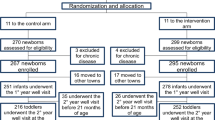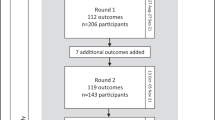Abstract
Objective:
To evaluate a universal obesity prevention intervention, which commenced at infant age 4–6 months, using outcome data assessed 6 months after completion of the first of two intervention modules and 9 months from baseline.
Design:
Randomised controlled trial of a community-based early feeding intervention.
Subjects and methods:
Six hundred and ninety-eight first-time mothers (mean age 30±5 years) with healthy term infants (51% male) aged 4.3±1.0 months at baseline. Mothers and infants were randomly allocated to self-directed access to usual care or to attend two group education modules, each delivered over 3 months, that provided anticipatory guidance on early feeding practices. Outcome data reported here were assessed at infant age 13.7±1.3 months. Anthropometrics were expressed as z-scores (WHO reference). Rapid weight gain was defined as change in weight-for-age z-score (WAZ) of >+0.67. Maternal feeding practices were assessed via self-administered questionnaire.
Results:
There were no differences according to group allocation on key maternal and infant characteristics. At follow-up (n=598 (86%)), the control group infants had higher BMI-for-age z-score (BMIZ) (0.42±0.85 vs 0.23±0.93, P=0.009) and were more likely to show rapid weight gain from baseline to follow-up (odds ratio (OR)=1.5, confidence interval (CI) 95%=1.1–2.1, P=0.014). Mothers in the control group were more likely to report using non-responsive feeding practices that fail to respond to infant satiety cues such as encouraging eating by using food as a reward (15% vs 4%, P=0.001) or using games (67% vs 29%, P<0.001).
Conclusions:
These results provide early evidence that anticipatory guidance targeting the ‘when, what and how’ of solid feeding can be effective in changing maternal feeding practices and, at least in the short term, reducing anthropometric indicators of childhood obesity risk. Analyses of outcomes at later ages are required to determine if these promising effects can be sustained.
This is a preview of subscription content, access via your institution
Access options
Subscribe to this journal
Receive 12 print issues and online access
$259.00 per year
only $21.58 per issue
Buy this article
- Purchase on Springer Link
- Instant access to full article PDF
Prices may be subject to local taxes which are calculated during checkout

Similar content being viewed by others
References
Yanovski JA . Intervening during infancy to prevent pediatric obesity. Obesity 2011; 19: 1321–1322.
Han J, Lawlor D, Kimm S . Childhood obesity. Lancet 2010; 375: 1737.
Lobstein T, Baur L, Uauy R . Obesity in children and young people: a crisis in public health. Obes Rev 2004; 5 (Suppl 1): 4–85.
Hesketh KD, Campbell KJ . Interventions to prevent obesity in 0-5 year olds: an updated systematic review of the literature. Obesity 2010; 18: S27–S35.
Summerbell CD, Waters E, Edmunds LD, Kelly S, Brown T, Campbell KJ . Interventions for preventing obesity in children. Update of Cochrane Database Syst Rev 2002; 2: CD001871 The Cochrane Collaboration 2005.
Flodmark CE, Marcus C, Britton M . Interventions to prevent obesity in children and adolescents: a systematic literature review. Int J Obes Relat Disorders 2006; 30: 579.
Anzman SL, Rollins BY, Birch LL . Parental influence on children's early eating environments and obesity risk: implications for prevention. Int J Obes 2010; 34: 1116–1124.
Ciampa PJ, Kumar K, Barkin SL, Sanders LM, Yin HS, Perrin EM et al. Interventions aimed at decreasing obesity in children younger than 2 years. Arch Pediatr Adolesc Med 2010; 164: 1098–1104.
Birch LL, Davison KK . Family environmental factors influencing the developing behavioural controls of food intake and childhood overweight. Pediatr Clin North Am 2001; 48: 893–907.
DiSantis KI, Hodges EA, Johnson SL, Fisher JO . The role of responsive feeding in overweight during infancy and toddlerhood: a systematic review. Int J Obes 2011; 35: 480–492.
Robinson S, Marriott L, Poole J, Crozier S, Borland S, Lawrence W et al. Dietary patterns in infancy: the importance of maternal and family influences on feeding practice. Br J Nutr 2007; 98: 1029–1037.
Skinner JD, Carruth BR, Bounds W, Zeigler P, Reidy K . Do food-related experiences in the first 2-years of life predict dietary variety in school-aged children? J Nutr Educ Behav 2002; 34: 310.
Craigie AM, Lake AA, Kelly SA, Adamson AJ, Mathers JC . Tracking of obesity-related behaviours from childhood to adulthood: a systematic review. Maturitas 2011; 70: 266–284.
Wardle J, Cooke L . Genetic and environmental determinants of children's food preferences. Br J Nutr 2008; 99: S15.
Benton D . Role of parents in the determination of the food preferences of children and the development of obesity. Int J Obes 2004; 28: 858–869.
Dovey TM, Staples PA, Gibson EL, Halford JCG . Food neophobia and [ `]picky/fussy' eating in children: A review. Appetite 2008; 50: 181–193.
Maier A, Chabanet C, Schaal B, Issanchou S, Leathwood P . Effects of repeated exposure on acceptance of initially disliked vegetables in 7-month old infants. Food Quality Preference 2007; 18: 1023–1032.
Daniels L, Magarey A, Battistutta D, Nicholson J, Farrell A, Davidson G et al. The NOURISH randomised control trial: positive feeding practices and food preferences in early childhood—a primary prevention program for childhood obesity. BMC Public Health 2009; 9: 387.
Laws P, Sullivan EA Australia's Mothers and Babies 2007. Perinatal Statistics. Cat. no. PER 48. Series no. 23. AIHW: Canberra 2009.
Kessler R, Andrews G, Colpe L, Hiripi E, Mroczek D, Normand S et al. Short screening scales to monitor population prevalences and trends in non-specific psychological distress. Psychol Med 2002; 32: 959–976.
Cooke L . The importance of exposure for healthy eating in childhood: a review. J Hum Nutr Diet 2007; 20: 294–301.
Satter E . Child of Mine. Feeding With Love and Good Sense. Bull Publishing Co: Boulder, Colorado, 2000.
WHO. WHO Child Growth Standards: Length/Height-for-Age, Weight-for-Age, Weight-for-Length, Weight-for Height and Body Mass Index-for-Age: Methods and Development. World Health Organization: Geneva, 2006.
Ong K, Loos R . Rapid infancy weight gain and subsequent obesity: Systematic reviews and hopeful suggestions. Acta Paediatr 2006; 95: 904–908.
Baughcum A, Powers S, Bennett-Johnson S, Chamberlin L, Deeks C, Jain A et al. Maternal feeding practices and belief and their relationship to overweight in early childhood. J Dev Behav Pediatr 2001; 22: 391–208.
Chan L, Magarey AM, Daniels LA . Maternal feeding practices and feeding behaviors of Australian children aged 12–36 months. Matern Child Health J 2011; 15: 1363–1371.
Satter E . The feeding relationship: problems and interventions. J Pediatr 1990; 117 (2 Part 2): S181–189.
Australian Bureau of Statistics. Information Paper: An Introduction to Socio-Economic Indexes for Areas (SEIFA), 2006. Canberra.
Cameron N, Preece MA, Cole TJ . Catch-up growth or regression to the mean? Recovery from stunting revisited. Am J Hum Biol 2005; 17: 412–417.
Healy MJ, Goldstein H . Regression to the mean. Ann Hum Biol 1978; 5: 277–280.
Cole TJ . Conditional reference charts to assess weight gain in British infants. Arch Disease Child 1995; 73: 8–16.
Monteiro POA, Victora CG . Rapid growth in infancy and childhood and obesity in later life – a systematic review. Obes Rev 2005; 6: 143–154.
Baird J, Fisher D, Lucas P, Kleijnen J, Roberts H, Law C . Being big or growing fast: systematic review of size and growth in infancy and later obesity. Br Med J 2005; 331: 929–931.
Ong KKL, Ahmed ML, Emmett PM, Preece MA, Dunger DB . Association between postnatal catch-up growth and obesity in childhood: prospective cohort study. Br Med J 2000; 320: 967–971.
Paul IM, Savage JS, Anzman SL, Beiler JS, Marini ME, Stokes JL et al. Preventing obesity during infancy: a pilot Study. Obesity 2011; 19: 353–361.
Birch LL . Development of food preferences. Annu Rev Nutr 1999; 19: 41–62.
Skinner JD, Carruth BR, Wendy B, Ziegler PJ . Children’s food preferences: a longitudinal analysis. J Am Diet Assoc 2002; 102: 1638–1647.
Hurley KM, Cross MB, Hughes SO . A systematic review of responsive feeding and child obesity in high-income countries. J Nutr 2011; 141: 495–501.
Anzman SL, Birch LL . Low inhibitory control and restrictive feeding practices predict weight outcomes. J Pediatr 2009; 155: 651–656.
Gubbels JS, Kremers SPJ, Stafleu A, Dagnelie PC, Goldbohm RA, de Vries NK et al. Diet-related restrictive parenting practices. Impact on dietary intake of 2-year-old children and interactions with child characteristics. Appetite 2009; 52: 423–429.
Ventura A, Birch L . Does parenting affect children’s eating and weight status? Int J Behav Nutr Phys Activ 2008; 5: 15–44.
Birch LL, Ventura AK . Preventing childhood obesity: what works. In J Obes 2009; 33: S74–S81.
Acknowledgements
NOURISH was funded 2008–2010 by the Australian National Health and Medical Research Council (Grant 426704). Additional funding was provided by HJ Heinz (post-doctoral fellowship KM), Meat and Livestock Australia (MLA), Department of Health South Australia, Food Standards Australia New Zealand (FSANZ), Queensland University of Technology, and NHMRC Career Development Award 390136 (JMN). We acknowledge the NOURISH investigators: Professors Ann Farrell, Geoffrey Cleghorn and Geoffrey Davidson. We acknowledge the contribution to intervention development by Associate Professor Jordana Bayer and the preparation of the growth data by Dr Seema Mihrshahi. We sincerely thank all our participants and recruiting, intervention and assessment staff including Dr Carla Rogers, Jacinda Wilson, Jo Meedeniya, Gizelle Wilson and Chelsea Mauch.
AUTHOR CONTRIBUTIONS
LD and AM led the conception, design and successful funding application for NOURISH. DB contributed methodological expertise to the RCT design and analysis protocols. Analysis was mentored by DB and undertaken by KM. RP and JN developed the intervention and RP had substantial input into recruitment, intervention delivery and data acquisition. The manuscript was drafted by LD and KM. All authors contributed to interpretation of the data, provided critical input into manuscript preparation and approved the final version to be published.
Author information
Authors and Affiliations
Corresponding author
Ethics declarations
Competing interests
The authors declare no conflict of interest.
Rights and permissions
About this article
Cite this article
Daniels, L., Mallan, K., Battistutta, D. et al. Evaluation of an intervention to promote protective infant feeding practices to prevent childhood obesity: outcomes of the NOURISH RCT at 14 months of age and 6 months post the first of two intervention modules. Int J Obes 36, 1292–1298 (2012). https://doi.org/10.1038/ijo.2012.96
Received:
Revised:
Accepted:
Published:
Issue Date:
DOI: https://doi.org/10.1038/ijo.2012.96
Keywords
This article is cited by
-
Understanding the pathways between prenatal and postnatal factors and overweight outcomes in early childhood: a pooled analysis of seven cohorts
International Journal of Obesity (2023)
-
Working Mothers’ Infant Feeding Experiences During Their Children’s Transition to Child Care: A Qualitative Study
Journal of Child and Family Studies (2023)
-
Grow well/Crecer bien: a protocol for research on infant feeding practices in low-income families
BMC Public Health (2020)
-
Evaluation of an eHealth intervention aiming to promote healthy food habits from infancy -the Norwegian randomized controlled trial Early Food for Future Health
International Journal of Behavioral Nutrition and Physical Activity (2019)
-
Prenatal education of overweight or obese pregnant women to prevent childhood overweight (the ETOIG study): an open-label, randomized controlled trial
International Journal of Obesity (2019)



